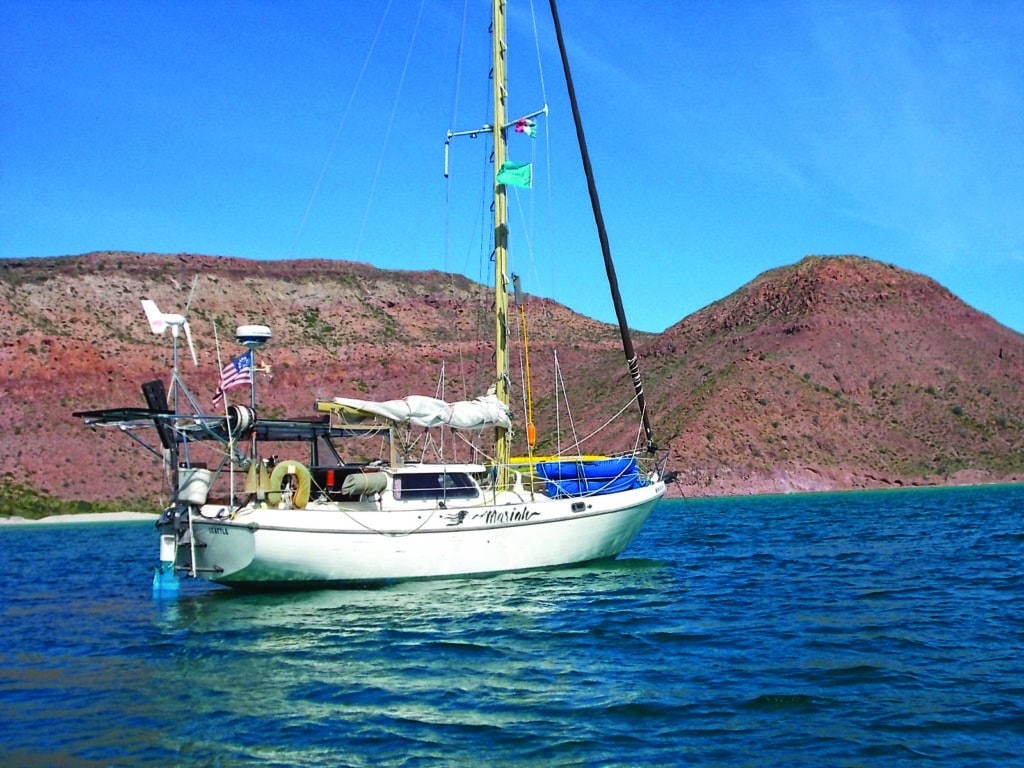
Nine years ago I decided to take the leap from trailer-sailer to smaller ocean cruiser, and went looking for an affordable, seaworthy and comfortable sailboat capable of exploring the Pacific Northwest and maybe, someday, sailing around the world. When I first viewed Mariah, a 1978 Gulf Pilothouse 32 I’d found on Craigslist, I was struck by her lines, her interior volume and the flush deck. My wife, Vinnie, who is prone to claustrophobia, appreciated the view and the light from the pilothouse windows. I liked the idea of an inside steering station protected from the cold and the sun. Mariah appeared to be a proper “big little yacht,” so with great hopes and expectations, we took the plunge.
The Gulf Pilothouse 32 was designed by William Garden. Between 1965 and 1990, first Gulf Marine Products and later Capital Yachts built a total of 400 of them.
Below the waterline, a full keel helps the boat track steadily, supports the rudder and partially protects the fixed three-blade propeller. A bulge in the keel allows the engine to fit below the cabin sole, adding to the interior roominess. I have twice fully dried out safely on Mariah’s full keel after accidental groundings.
Thanks to the boat’s beam, which is carried well aft, the T-shaped cockpit is deep and roomy. The aft bench is a comfortable 65 inches wide, and plywood fillers create 78-inch-long port and starboard berths — perfect for naps outside. We feel secure in the 34-inch-deep cockpit, although the drains are small and bluewater sailors voice concern over the flooding risk if pooped. Newer models have a somewhat shallower cockpit.
On deck, the medium-profile pilothouse is easy to stand on when working with the mainsail. The flush foredeck has a slight camber where the mast is stepped and is great for dinghy storage. Depending on the model year, the bow section of the deck is either a 6-inch-deep triangular well or is flush with a two-piece anchor-locker hatch.
The Gulf 32 was designed as a cutter, but Mariah is rigged as a sloop with a 120 percent roller-furling genoa. Mariah’s mainsheet was originally at the end of the boom, but later models came with a midboom traveler arrangement that clears the cockpit of lines. This is the setup we now use on Mariah.
The Gulf 32’s standard interior layout places the galley, steering station, small chart table and quarter berth in the pilothouse. Amidships, the main saloon has a 6-foot bench to port, an L-shaped bench to starboard, and a bulkhead-mounted fold-down table. The forward area houses a head, hanging locker and V-berth. Mariah’s early-model interior has a U-shaped settee and space to build two 41-inch-wide quarter berths.
With a full keel, short waterline and heavy displacement, the Gulf 32 is an understandably poor performer in light winds. However, she sails at a reasonable 5 to 6 knots in a moderate breeze and has respectable windward ability for her design. At 2,500 rpm, her 37-horsepower Westerbeke pushes her at 5 knots until seas get bumpy. Her steering response in reverse is poor to absent.
I have had to replace the rusted black-iron diesel tank and deal with leaks around the pilothouse windows. Other areas to inspect are the cored side decks (for leaks and delamination), and the deck and bulkhead under the mast step. Mariah proved herself reliable and comfortable throughout an eight-month cruise from Seattle to Puerto Vallarta, Mexico, and back to San Diego in 2012 and 2013. I still get regular compliments on her design. A Gulf Pilothouse 32 can be found for $30,000 to $45,000, depending on condition.
Ken Painter, his wife, Vinnie, and their two teenage children, Maya and Dylan, continue to sail Mariah in the Pacific Northwest. Ken has documented his sail from Seattle to Mexico on Mariah at www.kenpainter.blogspot.com.








